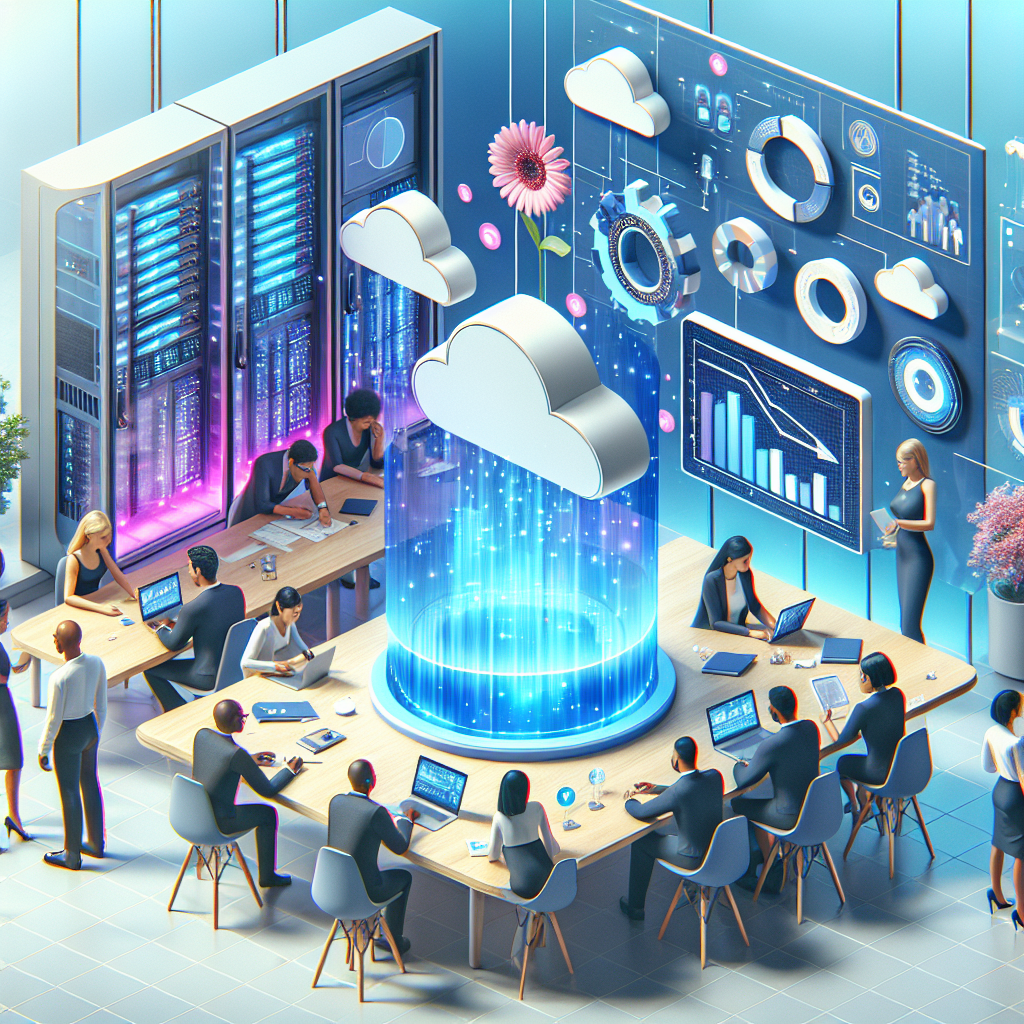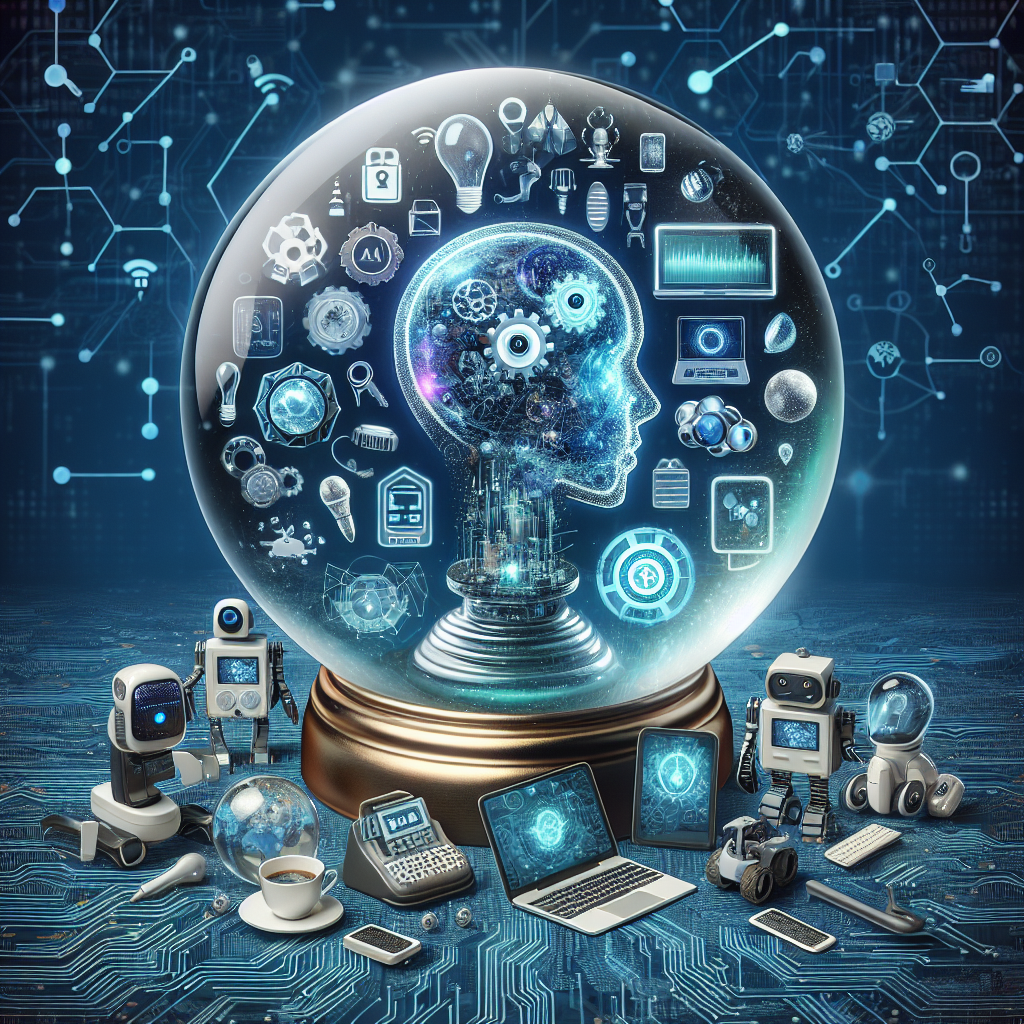Your cart is currently empty!
Tag: Trends

The Future of IT Outsourcing: Trends to Watch in the Digital Age
IT outsourcing has been a popular choice for businesses looking to reduce costs, access specialized skills, and increase flexibility. As we enter the digital age, the future of IT outsourcing is undergoing significant changes. Here are some key trends to watch in the coming years:1. Emphasis on Digital Transformation: With the increasing importance of digital technologies in business operations, IT outsourcing providers are focusing more on digital transformation services. This includes services such as cloud computing, artificial intelligence, and big data analytics. Businesses are looking for outsourcing partners that can help them navigate the complexities of digital transformation and stay competitive in the digital age.
2. Rise of Automation and AI: Automation and artificial intelligence are revolutionizing the IT outsourcing industry. Businesses are increasingly looking for outsourcing providers that can offer automated solutions to streamline their operations and improve efficiency. AI-powered tools are being used to automate routine tasks, reduce errors, and enhance decision-making processes.
3. Shift towards Outcome-based Pricing Models: Traditional IT outsourcing contracts were based on fixed pricing models, where services were billed on a per-hour or per-project basis. However, in the digital age, businesses are looking for more flexible pricing models that are based on outcomes and performance. Outcome-based pricing models tie the cost of services to the results delivered, incentivizing outsourcing providers to deliver tangible business value.
4. Focus on Cybersecurity: With the rise of cyber threats and data breaches, cybersecurity has become a top priority for businesses. IT outsourcing providers are increasingly offering cybersecurity services to help businesses protect their sensitive data and systems. Businesses are looking for outsourcing partners that can provide robust cybersecurity solutions to safeguard their digital assets.
5. Expansion of Nearshore and Onshore Outsourcing: While offshore outsourcing has been a popular choice for businesses looking to reduce costs, there is a growing trend towards nearshore and onshore outsourcing. Nearshore outsourcing involves partnering with providers in neighboring countries, while onshore outsourcing involves working with providers in the same country. Nearshore and onshore outsourcing offer advantages such as closer proximity, cultural alignment, and better communication, making them attractive options for businesses in the digital age.
6. Collaboration with Startups and Innovation Hubs: In the digital age, innovation is key to staying ahead of the competition. IT outsourcing providers are increasingly collaborating with startups and innovation hubs to drive innovation and develop cutting-edge solutions. By partnering with startups, outsourcing providers can access fresh ideas, specialized skills, and new technologies to meet the evolving needs of businesses.
In conclusion, the future of IT outsourcing is bright in the digital age. Businesses are looking for outsourcing partners that can help them navigate digital transformation, leverage automation and AI, offer flexible pricing models, prioritize cybersecurity, and provide innovative solutions. By staying abreast of these trends, businesses can ensure they are well-positioned to succeed in the digital age.

The Future of Managed Service Providers: Trends and Innovations to Watch Out For
Managed Service Providers (MSPs) play a crucial role in helping businesses maintain and optimize their IT infrastructure. As technology continues to evolve at a rapid pace, MSPs are also evolving to meet the changing needs of their clients. In this article, we will explore the future of MSPs and the trends and innovations to watch out for in the coming years.One of the key trends that MSPs are embracing is the shift towards proactive IT management. In the past, MSPs primarily focused on reactive support, fixing issues as they arose. However, with the increasing complexity of IT systems and the growing importance of technology to businesses, MSPs are now moving towards a proactive approach to IT management. This involves monitoring systems in real-time, predicting and preventing issues before they occur, and continuously optimizing IT performance.
Another trend that is shaping the future of MSPs is the adoption of artificial intelligence (AI) and machine learning. These technologies are revolutionizing the way MSPs deliver services by enabling them to automate routine tasks, analyze vast amounts of data, and make data-driven decisions. AI and machine learning are being used to enhance security, improve system performance, and optimize resource allocation, ultimately leading to a more efficient and effective IT management process.
Cloud computing is also playing a significant role in the evolution of MSPs. With the increasing adoption of cloud services by businesses, MSPs are expanding their offerings to include cloud management and migration services. This allows businesses to leverage the scalability, flexibility, and cost savings of cloud computing while offloading the management and maintenance of their cloud infrastructure to MSPs.
In addition to these trends, MSPs are also exploring new technologies such as Internet of Things (IoT), edge computing, and blockchain. These technologies offer new opportunities for MSPs to provide innovative solutions to their clients, such as IoT device management, edge computing optimization, and blockchain-based security services.
Overall, the future of MSPs is bright, with continued growth and innovation on the horizon. By embracing proactive IT management, adopting AI and machine learning, expanding into cloud services, and exploring new technologies, MSPs are well-positioned to meet the evolving needs of businesses in the digital age. Businesses looking to stay ahead of the curve should keep an eye on these trends and innovations in the coming years.

Exploring the Future of Cloud Computing: Trends and Innovations
Cloud computing has revolutionized the way businesses store, manage, and access their data. With the increasing demand for more efficient and flexible IT solutions, the future of cloud computing looks promising with new trends and innovations emerging to meet the evolving needs of businesses.One of the key trends in cloud computing is the move towards hybrid cloud solutions. Hybrid cloud combines the benefits of both public and private cloud environments, allowing businesses to leverage the scalability and cost-effectiveness of public clouds while maintaining the security and control of private clouds. This hybrid approach is becoming increasingly popular as businesses seek to optimize their IT infrastructure and workload management.
Another trend in cloud computing is the rise of edge computing. Edge computing involves processing data closer to where it is generated, rather than relying on centralized data centers. This approach reduces latency and improves performance for applications that require real-time processing, such as IoT devices and autonomous vehicles. By distributing computing resources closer to the edge of the network, businesses can improve efficiency and deliver faster, more responsive services to their customers.
Innovations in cloud computing are also driving the future of the industry. One of the most exciting developments is the adoption of artificial intelligence and machine learning in cloud services. These technologies enable businesses to automate processes, analyze vast amounts of data, and make data-driven decisions in real-time. By integrating AI and machine learning into cloud platforms, businesses can unlock new insights, improve efficiency, and drive innovation.
Another innovation shaping the future of cloud computing is the rise of serverless computing. Serverless computing eliminates the need for businesses to manage servers and infrastructure, allowing them to focus on developing and deploying applications. By abstracting away the underlying infrastructure, serverless computing simplifies development processes, reduces costs, and improves scalability. This approach is particularly beneficial for businesses looking to accelerate their digital transformation and innovate at a faster pace.
As the demand for cloud computing continues to grow, businesses can expect to see further advancements in areas such as cloud security, multi-cloud management, and containerization. These trends and innovations will help businesses stay competitive, improve operational efficiency, and drive growth in the digital economy.
In conclusion, the future of cloud computing is bright, with new trends and innovations shaping the industry and enabling businesses to unlock new opportunities. By embracing hybrid cloud solutions, edge computing, AI and machine learning, serverless computing, and other advancements, businesses can harness the power of cloud computing to drive innovation, improve efficiency, and stay ahead of the competition.

Network Management Trends to Watch in 2021
As technology continues to evolve at a rapid pace, network management is becoming increasingly important for businesses of all sizes. In 2021, there are several key trends in network management that are shaping the way organizations approach their IT infrastructure. From the rise of cloud-based solutions to the growing importance of cybersecurity, here are some network management trends to watch in 2021.One of the biggest trends in network management for 2021 is the shift towards cloud-based solutions. With more businesses moving their operations to the cloud, network management is also moving away from traditional on-premises systems towards cloud-based platforms. This allows for greater flexibility, scalability, and cost savings for organizations, as they can easily scale their network infrastructure up or down as needed without the need for physical hardware.
Another trend to watch in 2021 is the increasing importance of cybersecurity in network management. With cyber threats on the rise, organizations are placing a greater emphasis on securing their networks and data. This includes implementing robust security measures such as firewalls, encryption, and multi-factor authentication, as well as regularly monitoring and updating their network infrastructure to identify and mitigate any potential vulnerabilities.
Furthermore, the rise of remote work due to the COVID-19 pandemic has also had a significant impact on network management trends in 2021. With more employees working from home, organizations are having to adapt their network management strategies to accommodate remote access and ensure secure connections for their remote workforce. This includes implementing virtual private networks (VPNs), secure access controls, and remote monitoring tools to ensure the security and performance of their networks.
In addition, the increasing use of Internet of Things (IoT) devices in the workplace is also shaping network management trends in 2021. With more devices connecting to the network, organizations are having to manage a larger and more diverse network infrastructure. This includes implementing network segmentation to separate IoT devices from critical systems, as well as implementing network monitoring tools to track the performance and security of these devices.
Overall, network management in 2021 is becoming more complex and challenging as organizations continue to adopt new technologies and embrace digital transformation. By staying informed on the latest trends and best practices in network management, organizations can ensure that their networks are secure, reliable, and scalable to meet the demands of today’s digital economy.

The Future of Managed Service Providers: Trends and Technologies to Watch
Managed service providers (MSPs) play a crucial role in helping businesses navigate the ever-evolving landscape of technology. As technology continues to advance at a rapid pace, MSPs are tasked with staying ahead of the curve and providing cutting-edge solutions to their clients. In this article, we will explore the trends and technologies that are shaping the future of MSPs.One of the key trends that MSPs are currently facing is the shift towards cloud-based services. With more and more businesses moving their operations to the cloud, MSPs are being called upon to provide expertise in managing and securing cloud environments. This includes helping clients migrate their data and applications to the cloud, as well as implementing robust security measures to protect sensitive information.
Another trend that is shaping the future of MSPs is the increasing demand for managed cybersecurity services. With cyber threats becoming more sophisticated and prevalent, businesses are looking to MSPs to provide comprehensive security solutions to protect their networks and data. MSPs are now offering services such as threat detection and response, vulnerability assessments, and security awareness training to help clients defend against cyber attacks.
In addition to cloud and cybersecurity services, MSPs are also embracing technologies such as artificial intelligence (AI) and machine learning to enhance their offerings. AI-powered tools can help MSPs automate routine tasks, improve efficiency, and provide predictive analytics to anticipate and prevent potential issues before they arise. By leveraging these technologies, MSPs can deliver more proactive and personalized services to their clients.
As the role of MSPs continues to evolve, it is essential for them to stay abreast of the latest trends and technologies in the industry. By investing in training and development, staying informed about emerging technologies, and adapting their services to meet the changing needs of their clients, MSPs can position themselves as trusted advisors in a rapidly changing technological landscape.
In conclusion, the future of managed service providers is bright, with opportunities for growth and innovation abound. By embracing cloud services, cybersecurity solutions, and emerging technologies such as AI, MSPs can continue to provide valuable services to their clients and remain at the forefront of the industry. As businesses continue to rely on technology to drive their operations, MSPs will play a crucial role in helping them succeed in the digital age.

The Future of Help Desk: Trends and Technologies to Watch
As technology continues to advance at a rapid pace, the future of help desks is evolving as well. With the rise of artificial intelligence, automation, and other emerging technologies, help desks are becoming more efficient, responsive, and user-friendly than ever before. In this article, we will explore some of the key trends and technologies that are shaping the future of help desks.One of the most significant trends in the world of help desks is the increasing use of artificial intelligence (AI) and machine learning. AI-powered chatbots are now being used to provide instant assistance to customers, answer common questions, and even troubleshoot technical issues. These chatbots can quickly analyze customer inquiries, provide relevant information, and direct users to the appropriate resources for further assistance. This not only helps to improve customer satisfaction but also allows help desk agents to focus on more complex issues that require human intervention.
Another trend that is shaping the future of help desks is the growing focus on self-service options. Many companies are now offering self-service portals and knowledge bases where customers can find answers to their questions and troubleshoot common issues on their own. By providing customers with the tools and resources they need to resolve issues independently, companies can reduce the volume of incoming support requests and improve overall efficiency.
Automation is also playing a key role in the future of help desks. By automating routine tasks such as ticket triaging, routing, and escalation, help desk agents can spend more time focusing on higher-value activities that require human expertise. Automation can also help to streamline workflows, reduce response times, and improve overall service quality.
In addition to AI, self-service options, and automation, other technologies such as augmented reality (AR) and virtual reality (VR) are also starting to make their way into the world of help desks. AR and VR technologies can be used to provide remote assistance, guide customers through troubleshooting processes, and even offer virtual training sessions. These immersive technologies can help to enhance the customer experience, improve problem-solving capabilities, and reduce the need for on-site support visits.
Overall, the future of help desks is bright, with the adoption of AI, automation, self-service options, and other emerging technologies helping to drive innovation and improve customer support. By staying ahead of these trends and embracing new technologies, companies can position themselves for success in the increasingly digital and fast-paced world of customer service.

The Future of Business Continuity: Trends and Technologies to Watch
Business continuity is a critical aspect of any organization’s strategy for ensuring that operations can continue in the face of unexpected disruptions. As technology evolves and new challenges emerge, the future of business continuity is constantly evolving. Here are some key trends and technologies to watch in the coming years.1. Cloud-based solutions: The cloud has revolutionized the way businesses operate, offering increased flexibility, scalability, and cost-effectiveness. Cloud-based business continuity solutions are becoming increasingly popular, allowing organizations to store data and applications off-site and access them in the event of a disaster.
2. Artificial intelligence and machine learning: AI and machine learning technologies are being used to enhance business continuity planning and response. These technologies can analyze vast amounts of data to predict potential disruptions and automate response processes, helping organizations to minimize downtime and recover more quickly.
3. Internet of Things (IoT): The IoT is connecting devices and sensors to the internet, providing real-time data on everything from equipment performance to environmental conditions. This data can be used to improve business continuity planning by identifying vulnerabilities and predicting potential disruptions before they occur.
4. Cybersecurity: Cyber attacks are a major threat to business continuity, with hackers constantly seeking to disrupt operations and steal sensitive data. As cyber threats evolve, organizations must invest in robust cybersecurity measures to protect their systems and data.
5. Remote work solutions: The COVID-19 pandemic has accelerated the shift towards remote work, highlighting the importance of ensuring that employees can work effectively from anywhere. Business continuity plans must now include provisions for remote work, including secure access to company systems and data.
6. Blockchain technology: Blockchain technology offers a secure and transparent way to store and share data, making it ideal for ensuring the integrity of critical information during a disruption. By leveraging blockchain technology, organizations can enhance the security and resilience of their business continuity plans.
7. Data analytics: Data analytics can provide valuable insights into business operations, helping organizations to identify trends and patterns that may impact continuity. By analyzing data from various sources, organizations can make more informed decisions and proactively address potential disruptions.
In conclusion, the future of business continuity is evolving rapidly, driven by advancements in technology and changes in the business landscape. By staying abreast of these trends and technologies, organizations can better prepare for and respond to disruptions, ensuring that their operations remain resilient and sustainable in the face of uncertainty.

Top Trends in Managed Services: What Businesses Need to Know
Managed services have become an integral part of modern businesses, allowing companies to outsource IT tasks and focus on their core competencies. As technology continues to evolve, so do managed services, with new trends shaping the industry. Here are the top trends in managed services that businesses need to know about:1. Artificial Intelligence and Machine Learning: AI and machine learning are revolutionizing managed services by enabling predictive maintenance, automated troubleshooting, and improved security measures. These technologies can analyze large amounts of data to identify patterns and anomalies, allowing businesses to proactively address issues before they impact operations.
2. Cloud Computing: Cloud computing has become a popular choice for businesses looking to scale their IT infrastructure without the need for costly hardware investments. Managed service providers are increasingly offering cloud services, allowing businesses to access their data and applications from anywhere, at any time.
3. Cybersecurity: With the rise of cyber threats, cybersecurity has become a top priority for businesses of all sizes. Managed service providers are now offering advanced security solutions, such as intrusion detection and prevention, vulnerability assessment, and threat intelligence, to protect businesses from cyber attacks.
4. IoT Management: The Internet of Things (IoT) has transformed the way businesses operate, with connected devices collecting and transmitting data in real-time. Managed service providers are now offering IoT management services to help businesses monitor and manage their IoT devices, ensuring they operate efficiently and securely.
5. Remote Work Solutions: The COVID-19 pandemic has accelerated the shift towards remote work, with businesses relying on managed services to support their remote workforce. Managed service providers are offering solutions such as virtual desktop infrastructure, secure remote access, and collaboration tools to help businesses adapt to the new work environment.
6. Compliance and Regulation: With increasing regulations around data privacy and security, businesses need to ensure they are compliant with industry standards and regulations. Managed service providers are offering compliance management services to help businesses navigate complex regulatory requirements and avoid costly fines.
7. Managed Backup and Disaster Recovery: Data loss can have a devastating impact on businesses, leading to downtime, lost revenue, and damage to reputation. Managed service providers are offering backup and disaster recovery solutions to help businesses protect their data and quickly recover in the event of a disaster.
In conclusion, the managed services industry is constantly evolving to meet the changing needs of businesses. By staying informed about the latest trends and partnering with a reputable managed service provider, businesses can leverage technology to drive innovation, improve efficiency, and stay ahead of the competition.

The Future of Service Level Agreements: Trends to Watch in the Industry
Service Level Agreements (SLAs) have long been a crucial aspect of the relationship between service providers and their customers. These agreements outline the level of service that the provider is expected to deliver, including metrics such as uptime, response times, and resolution times. However, as technology and customer expectations continue to evolve, the future of SLAs is also changing. Here are some key trends to watch in the industry:1. Outcome-based SLAs: Traditionally, SLAs have been focused on inputs, such as the availability of a service or the speed of response to a customer issue. However, there is a growing trend towards outcome-based SLAs, where the focus is on the actual results achieved by the service provider. This shift reflects a move towards a more customer-centric approach, where the emphasis is on delivering tangible business value rather than just meeting technical benchmarks.
2. Real-time monitoring and reporting: With the increasing complexity and interdependence of IT systems, there is a growing need for real-time monitoring and reporting to ensure that SLAs are being met. Service providers are investing in advanced monitoring tools that can provide real-time visibility into the performance of their services, allowing them to proactively identify and address issues before they impact the customer.
3. AI-driven SLAs: Artificial intelligence (AI) is revolutionizing the way SLAs are managed. AI-powered algorithms can analyze vast amounts of data to predict and prevent service disruptions, optimize resources, and improve the overall performance of IT services. By leveraging AI, service providers can enhance the accuracy and effectiveness of their SLAs, leading to better outcomes for customers.
4. Customized SLAs: One size does not fit all when it comes to SLAs. Customers have unique requirements and priorities, and service providers are increasingly offering customized SLAs to meet these specific needs. By tailoring SLAs to individual customers, service providers can ensure that they are delivering the level of service that is most important to each customer, leading to increased satisfaction and loyalty.
5. Collaboration and partnership: As IT environments become more complex and interconnected, service providers are recognizing the importance of collaboration and partnership in meeting SLA requirements. By working closely with customers, vendors, and other stakeholders, service providers can ensure that SLAs are realistic, achievable, and aligned with the broader business goals of all parties involved.
In conclusion, the future of SLAs is evolving to meet the changing needs and expectations of customers in a rapidly evolving technological landscape. By embracing outcome-based SLAs, investing in real-time monitoring and AI-driven solutions, offering customized agreements, and fostering collaboration and partnership, service providers can ensure that they are delivering the level of service that their customers expect and deserve. Keeping an eye on these trends will be crucial for staying ahead in the competitive service provider industry.

The Future of Technical Support: Trends and Innovations to Watch Out For
As technology continues to evolve at a rapid pace, so too does the world of technical support. Gone are the days of waiting on hold for hours to speak to a representative or having to bring your device into a physical store for repairs. The future of technical support is all about convenience, efficiency, and innovation.One of the most significant trends in technical support is the rise of artificial intelligence (AI) and machine learning. These technologies are revolutionizing the way technical issues are diagnosed and resolved. AI-powered chatbots can now provide instant and personalized assistance to customers, answering common questions and guiding them through troubleshooting steps. Machine learning algorithms can also analyze vast amounts of data to predict and prevent future technical issues before they even occur.
Another trend to watch out for is the increasing use of remote support tools. With more people working remotely than ever before, the need for remote technical support has never been greater. Remote support tools allow technicians to access and troubleshoot devices from anywhere in the world, saving time and reducing the need for in-person or over-the-phone support.
Furthermore, the Internet of Things (IoT) is shaping the future of technical support. As more and more devices become connected to the internet, the potential for technical issues to arise increases. Technical support teams are now tasked with troubleshooting not just computers and smartphones, but also smart home devices, wearables, and even cars. This requires a deeper understanding of interconnected systems and the ability to provide support across a wide range of devices and platforms.
Finally, the future of technical support is all about personalization and proactive support. Companies are using data analytics and customer feedback to tailor support experiences to individual needs and preferences. This means that customers can receive personalized recommendations, proactive alerts about potential issues, and even on-demand support tailored to their specific needs.
In conclusion, the future of technical support is an exciting and rapidly evolving field. With the rise of AI, remote support tools, IoT, and personalized support experiences, the way we receive technical assistance is changing for the better. By keeping an eye on these trends and innovations, businesses can stay ahead of the curve and provide the best possible support experience for their customers.
